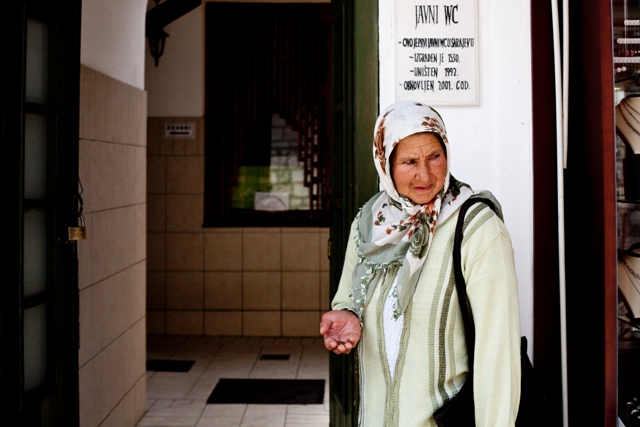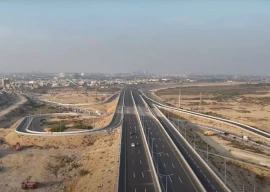
The siege of Sarajevo, which lasted from 1992 to 1995, has often been referred to as the ‘Holocaust of the ’90s, during which more than 10,000 people were killed by the Bosnian Serbs. The Srebrenica Genocide of 1995 is estimated at 8,000 Bosnian Muslims. Twenty years later, to those who have not followed how Bosnia rebuilt itself, Sarajevo is still considered ‘dangerous’.

The Eternal Flame. PHOTO: KHAULA JAMIL
But Sarajevo’s tainted past gives the city character. There is a terrifying story around each corner, and to get to know them, we attempted to figure out the less-touristy locations after an initial introduction to the city.
Several companies around the city offer war tours with poignant names such as ‘Never forget Srebrenica’ or ‘Times of Misfortune’. We opted for the latter and visited Kovači, the largest graveyard of Sarajevo, with 1,487 officially buried Muslims and fallen soldiers. Standing in a graveyard dotted with white graves, it was chilling and yet inspiring to be amongst the many brave men who gave up their lives for their country.

Veteran of the Bosnian war who walks around Old Town in full uniform, selling an article he wrote about his experience during the war. PHOTO: KHAULA JAMIL
A hill climb later, we could view Sarajevo in all its aesthetic and historic glory. The hills surrounding the city were lined with tall dark trees which concealed their own bloody tale. “Look there towards the black forests,” our guide said pointing towards the trees looming further up in the mountains above the city. “On the other side of those forests and mountains is Serbia, and that is where the Serbian snipers were always [stationed],” he said as he looked down at the exposed city of Sarajevo. “People down there were just sitting ducks for them.”
Amid the tales of bloodshed and doom, things like the famous Tunnel of Hope served as a reminder of the city’s humanity and courage. Built under the home of an elderly couple, Mr and Mrs Kolar, the tunnel acted like a lifeline for Sarajevo when the Serbs cut off all their supplies and contact with the outside world. Walking through the reconstructed tunnel, I kept imagining the soldiers who frequented the half-flooded hole with supplies every night, armed with just a torchlight and a passion to save their city.

A Sarajevo Rose. PHOTO: KHAULA JAMIL
Surrounded with memorabilia of the war, it was easy to play out in your mind hat must have happened during those nights. There is even a video of the elderly Mrs Kolar, who became affectionately known as Nana Sida after she served for three consecutive years, waiting at the mouth of the tunnel holding a jug of water and handing it out to every soldier who exited.
Scattered reminders of the war both haunt and uplift Sarajevo. On a walking tour of the Austro-Hungarian part of the city, we stopped to take in a reminder of a time when there was no violence in the name of religion. Tito Street bears the Eternal Flame, a memorial for those who died in World War II. Our guide recited what the flame stood for as written on the memorial — courage, bravery and solidarity.

Area called Kundurdziluk, Bascarsija in Sarajveo. PHOTO: KHAULA JAMIL
The same guide took us through the old city, to the vivid stalls of fruit and vegetables at the Markale Market. One of the biggest shelling attacks had taken place here during the siege, killing up to 66 people who had been shopping at the market. A glass case covers the shell now, which like all other shell marks on the road has been covered with resin or red rubber to preserve them. These marks are known as the ‘Sarajevo Roses’.

Portrait display of 600 of the 8,000 Muslims massacred in the Srebrenica Genocide at Gallery 11/07/95. PHOTO: KHAULA JAMIL
While each location told its own story, the people were not too keen to speak of the past. From former soldiers who were once wounded in the war and were now working as translators, taxi drivers, memorabilia salesmen or shop keepers, to young college students, everyone was aware of the dark history but admitted that it was still very “hush hush”.
They may not be keen on talking about it, but the people of Sarajevo are determined to move on. The city has rebuilt its war-torn surroundings and its inhabitants display a high level of tolerance.

The domed monument in the Kovaci (martyrs) Cemetery is the grave of President Alija Izetbegovic, who died in October 2003. He led Bosnia to independence in 1992. PHOTO: KHAULA JAMIL
I took something back from Sarajevo that I have never taken from any other city I have visited — hope. Real hope, that if the Bosnians can figure out how to live together after a harsh war of hate, maybe we have a chance as well.
Published in The Express Tribune, Sunday Magazine, October 27th, 2013.
COMMENTS (6)
Comments are moderated and generally will be posted if they are on-topic and not abusive.
For more information, please see our Comments FAQ



1736727549-0/booktok-(1)1736727549-0-165x106.webp)
1721647706-0/BeFunky-collage-(5)1721647706-0-165x106.webp)


















Beautiful... I will visit that place in summer 2014 :)
He should also visit the Holocaust sites in Bangladesh and Balochistan.
May Allah bless Bosna Herzegovana. they were very brave peoples in front of Serbia/Russia n terrorism.
Heart warming story of very resilient people. Thank you
I wish all the citizens of Bosnia a bright future. Hopefully, humans will someday learn to live peacefully and not settle disputes through war, even if history (battle of Kosovo-1389) may prompt revenge 600 years later.
Hey good to see you having the lust of travel. don't stop traveling at any cost - however 'dangerous' the destination is . It broadens horizons .